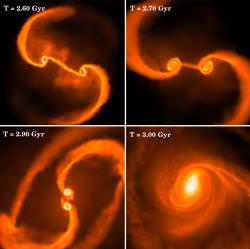Galaxies get bigger and bigger through galactic mergers. Two small galaxies come together, merge their stars, and you get a bigger galaxy. But astronomers have always wondered, what happens with the two supermassive black holes that seem to always lurk at the heart of galaxies. What happens when two compact objects with millions of times the mass of our sun collide? Good question.
An international team of physicists have developed a computer simulation designed to answer this very question. And in a recent article in Science Express, they published the results of the simulation.
It turns out the interaction depends a lot on the amount of hot gas surrounding each black hole. As they start to interact, this gas exerts a frictional force on the black holes, slowing down their spin rate. Once they get within the width of our solar system, they should start emitting gravitational waves, which continues to extract energy from the system. This causes them to continue coming together, and eventually merge.
This simulation is good news for experiments designed to search for gravitational waves. The mergers should be so energetic, they’ll generate gravitational waves detectable across space.
Original Source: Stanford News Release

